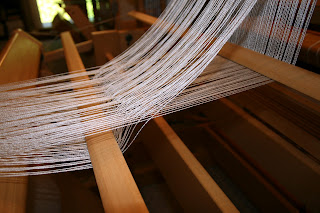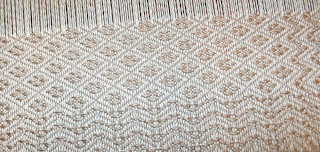There you have the first bit of weaving done on the Megado! It even has a mistake. Not overly exciting but it sure felt good to me. Its been a bit of a journey to get to this point (besides the trip to go and get the loom).
I had ordered the update to my Fiberworks-PCW program before we left and it was in the mailbox when we got home. I like a physical disc over a internet download. Been through too many computer crashes in my time I guess.
Bruce helped me with assembling the loom as its not quite like any loom I've had before. He also had taken the loom apart so he was the natural choice for help. There were some parts we got wrong, or used the wrong hardware. Correcting the assembly meant we now had nuts and bolts for other parts again. Oops!
We did have some missing bits that Jane Stafford sent me replacements for. Some new parts, like bumper pads, are still on order from Louet in Holland. Its fair to warn you that nothing with regards to this loom has happened fast. Jane was in the middle of teaching back to back full time workshops so getting information and the parts took time understandably.
Finally it was as together as we could do for now, so we turned our attention to the loom's module and computer. The module worked when plugged in as the solenoids all fired nicely in sequence. Okay, that's good. Now we are getting into foreign territory and I was learning as I went. I had to find either a small used laptop (which I couldn't find here locally) or find a small newer alternative. New computers have USB ports that you can simply plug in a cord and work with the external camera or other devise you want to use.
The loom's module has an older style serial port and the plug used for that looks like the old nine pin printer cords. I had to find something that would 'marry' them together. I wanted to talk with Louet Canada for their best advice and caught them away at Convergence, then closely followed by their annual inventory on their return! More waiting but I wanted to get this done right.
I went to a local technology store, Future Shop, and found a young lady in their computer department who was simply great. I brought the module in with me so they could see the unit and what it needed. She carefully listened to me and what the goals were and then we set out to find all that was needed. We got a (short) serial to USB cord and then found an extension 'USB to USB' cord so I can move the computer closer next to me while working. So far, so good!
We found a small Acer netbook computer with a ten inch screen in stock, last model and so on sale! No choice on the colour but they did add in for free loading up the weaving program onto the new computer and clearing off all the factory preset programs as it doesn't have a disc drive. I dashed home and brought in the Fiberworks disc! (see how a real disc helped out nicely?)
I think I've shown this picture to you before but it really does fit in nicely at this point of the story.
The computer is all set up with the software and I'm mostly familiar with the majority of it....up to the part that governs the weaving process. Before we get to that part I had to learn all about COMM ports (that's how they write that word... I'm not shouting :) The COMM port is the door way through which your computer allows data in and out. Some doors work better and luckily for my little computer, there is only one ( and only one available) and its COMM port 3 and it works! I like the way the computer proudly tells me the door is open.
Okay, so far, so good... next up is learning the steps for using the portion of the Fiberworks program for weaving. It meant reading, and rereading the manual and sort of doing 'fake' weaving. There is no warp on the loom but you treadle along and the computer doesn't know you don't throw a shuttle. This went okay but there's nothing like the real thing. So planned a warp for two scarves and decided on a simple point twill pattern that uses ten shafts. I thought for the first project I should keep the draft simple so I can concentrate on the methods and not get too complicated.
The first mistake I made was the silk yarn I chose. I don't know where my mind was at. Its a cone of 20/2 silk I got somewhere along the way and its not as tightly twisted as my usual from Treenway silks. I wound the warp in two large bouts, 6.5 yards long (two scarves both 72" long, 12 inches either ends for fringe allowance, take up, loom waste and some samples). I counted carefully and then decided to wind a couple extra warp ends just in case.
Not having warped a Megado before, I decided to look at it like a larger Spring loom and I followed the same procedures, and it all worked nicely.
Here the two warp bouts are waiting to be spread in the built in raddle.
At the back of the loom now and I'm starting to wind on. I used a brand new roll of crisp brown paper for the inaugural warp. This is where the first mistake came home to roost. The yarn halo'd and grabbed its mate next door. Crap. I fought with it until I realized an easier fix. Separate the lease sticks! Since they could slide on the support strings .....easy peasy!
The rest of the warp beamed on just fine and no more clingy issues.
Next up, threading. Its a simple ten shaft point twill. Well, maybe the process will become simple in time as I get used to the shaft arrangements but for now, not so much! The shafts are set *very* close together and so when it comes to reaching for heddles, its very hard to see where you are reaching to and what you actually come out with. I had to double check and count every one before and after threading and caught a mistake or three along the way. Oh by the way, mistake number 2 was, despite winding two extra ends, I was still one short.
Threading was finally done and sleying was up next. I used a 23 inch , 15 dent reed for my 30 epi.
That went much better except for the missed dent in the middle. Mistake number 3. Fixed that up and then laced on. Then, I held my breath and turned on the computer and module and using 8/2 cotton, wove the header you saw in the picture at the top of the post. Then I took out my weft yarn and wove the border. I didn't know how to shift from border to repeats so I deleted the border portion and then clicked on 'repeating loop' and got to work! It was going well! So I called Bruce to come and see the loom in action.
Mistake number 4: showing off. Closely followed by, I don't know why there is suddenly a mistake and then quickly learning the function 'unweaving'. Well, it had to happen sooner or later right?
This is where mistake number 1 came back to haunt me. The silk fused at the edges and so won't unweave.
So I let it sit for a day or two. Show it who's boss...
Next time I sat down on the bench I rolled the warp ahead and simply started over again. I got quite a bit done until I saw a double weft shot in one shed. It seems the program suddenly decided to remove a tie up square. Why I have no idea! Mistake number 5.
This is where I quit yesterday and went and wove on the Spring loom for a time. It likes me and behaves itself. Needless to say the learning curve has been steep, and complete with speed bumps that I placed there myself. I'll keep at the warp and if it all ends up as samples, then its not wasted.
Before I close I want to show you a special loom bench pillow. Margaret wove this overshot piece some years ago and made a bench pillow wrap of it using velcro and some foam. I clipped the velcro portions off and washed it. Then I took another pillow I had and sewed it over the top. Its very comfy and I added a small square of non skid matting to the bottom and so it doesn't slide on the bench. At least I got this right! :)
Well its nice to know that if I need a time out, there are other options to play with in the studio. This has been a lot like going back to school!











7 comments:
Wow, I am impressed with all your are learning with your new loom. I certainly don't think of your learning curve as mistakes only chances for you to increase your knowledge. The new pillow on your bench is just lovely, overshot will always be one of my favorites. Enjoy your new loom, you deserve it.
Yes, big learning curve but you're well on your way.
Here's something you should see if you can do with the Louet and software you're using. On my AVL V Series using WeavePoint in threading I can take my draft in the software and change it to tromp as writ for threading - then I just push the foot pedal and it raises each shaft to thread so there's never accidently threading a heddle on the wrong harness. This is a lifesaver since 40 harnesses are so close together, it would be a nightmare trying to make sure I got the right heddle/harness while threading without it.
That's quite a chunk of the learning curve that you've managed to work through already! My hat is off to you...and what a beautiful result. Oh the miles of gorgeous yardage ahead of you with this loom. But how nice to be able to move to old, comfortable friends when you need a break from all of that intensity and focus. Well done, Susan! You're well on your way.
Susan, loved reading your learning curve with "Margaret"! Like Cindie mentions, you can use the dobby for threading. Comes in really useful when you have a complicated threading rather than a straight one to do. The learning curse will continue, but the more you weave with Margaret, the more you get used to it all. Enjoy!
Hi Susan - I did try yesterday but Blogger was not happy with me !
Your story is great and what a lot of patience you have ! I think I'll stick to me easy Spring for now, that learning curve seems a bit too steep for my liking but you are doing a great job !
You, Margaret and the computer are going to be the best of friends very soon !
D
Beautiful loom. Lots of fun and happy times to come with her after the learning curve.
New loom blues - we've all been there and had similar happenings. You'll get past the learning curve and get to the fun part soon.
Post a Comment